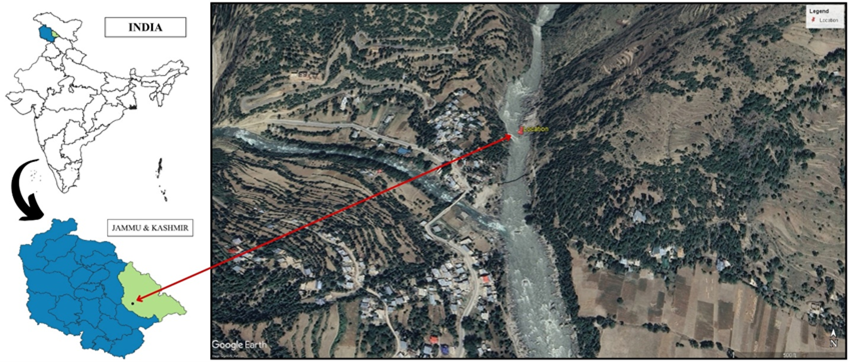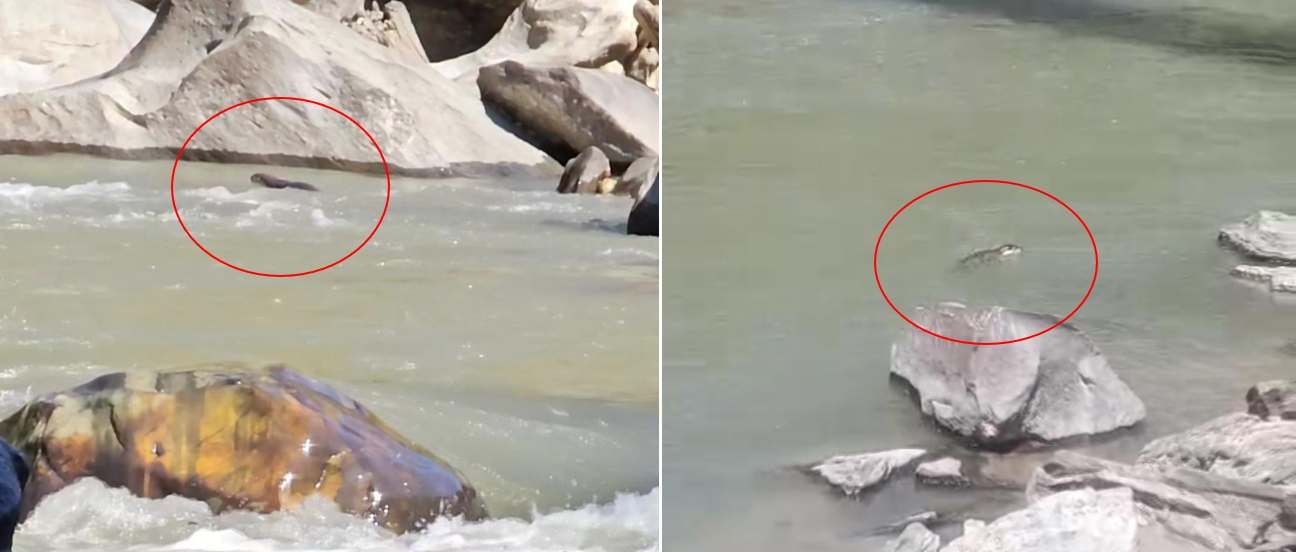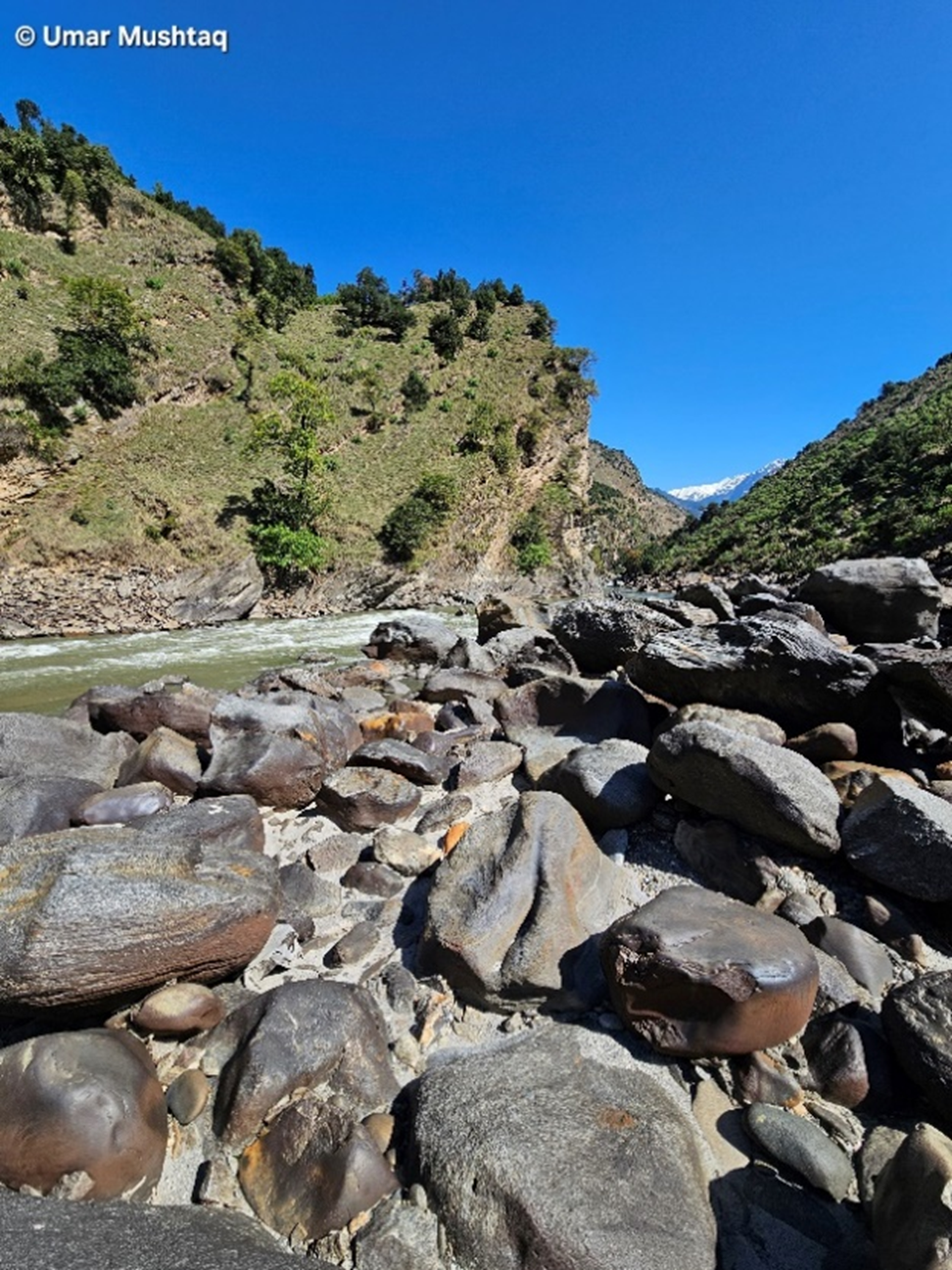IUCN/SSC Otter Specialist Group Bulletin

©IUCN/SCC Otter Specialist Group
Volume 42 Issue 4 (August 2025)
Citation: Mushtaq, U. and Ahmed, K. (2025). First Photographic Evidence of the Eurasian Otter (Lutra lutra) in a Tributary of Chenab River, Marusudar, Kishtwar, Jammu and Kashmir, India. IUCN Otter Spec. Group Bull. 42 (4): 194 - 197
First Photographic Evidence of the Eurasian Otter (Lutra lutra) in a Tributary of Chenab River, Marusudar, Kishtwar, Jammu and Kashmir, India.
Umar Mushtaq and Kaleem Ahmed*
Department of Wildlife Sciences Aligarh Muslim University, Aligarh, India-202002
*Corresponding Author Email: kahmed.wl@amu.ac.in
Received 3rd June 2025, accepted 2nd August 2025
Abstract: This study reports the first photographic evidence of the Eurasian otter (Lutra lutra) from the Marusudar River, a glacial tributary of the Chenab in Kishtwar, Jammu and Kashmir. Recorded in April 2024 at 1114m elevation, this sighting extends the species' known range in the western Himalayas. The oak-dominated, boulder-strewn habitat faces threats from sand mining, road construction, and hydropower projects. The finding highlights the need for targeted conservation of high-altitude Himalayan rivers to protect rare species like the Eurasian otter.
Keywords: Apex predator, Keystone species, Semi-aquatic carnivorous mammal, Western Himalayas.
INTRODUCTION
The Eurasian otter (Lutra lutra) is known from several river systems in Jammu and Kashmir, including the Indus in Ladakh (Shawl et al., 2008; Jamwal et al., 2016), the Neeru stream in Doda district (Singh et al., 2023), and the Kishanganga River in Bandipora district (Javid et al., 2024), demonstrating its presence across varying altitudes in the western Himalayas. Globally, the species has declined over the past 23 years (Roos et al., 2015) and is currently listed as “Near Threatened” by the IUCN (Loy et al., 2022) and in Appendix I of CITES (2023). In India, it receives the highest legal protection under Schedule I of the Wildlife (Protection) Amendment Act, 2022. This article documents the first photographic record of L. lutra from the Marusudar River in Kishtwar, expanding its known range and underscoring the urgent need for focused conservation in the region.
OBSERVATION AND HABITAT NOTE
During a biodiversity survey in Kishtwar, Jammu and Kashmir, we recorded the Eurasian otter (Lutra lutra) in the Marusudar River, a right-bank tributary of the Chenab (Figure 1). The otter was sighted twice - on April 7 and 9, 2024 - at 33°23'34.332'' N, 75°41'43.728'' E, altitude 1114 m (Figure 2). A single individual was observed both times at 1100 and 0940 hrs, using 10×50 binoculars and documented via smartphone video. Identification was based on Menon (2023). The otter was seen for ~20 minutes but was difficult to film due to its agility and the river’s fast current. The site had large boulders and diverse riparian vegetation including Quercus ilex, Alnusnitidia, Oleacuspidata, Acer caesium, and Pistacia integerrima (Figure 3). A nearby village engaged in sand mining and fishing. The Marusudar, formed by Batkot and Gumbar streams (also known as Warwan River), originates at ~5175 m and flows north-south through glaciated upper reaches (~2500–4700 m) with steep terrain and high cliffs, joining the Chenab near Bhandarkot (Romshoo et al., 2017).



CONCLUSIONS
This study confirms the Eurasian otter’s presence in the Marusudar River, extending its known range in the Indian Himalayas. Given its role as an indicator of healthy aquatic ecosystems, urgent conservation action is needed as habitat degradation, poaching, and human disturbances threaten its survival. Targeted research using modern tools is essential to guide effective protection efforts.
Acknowledgements - The authors are grateful to the Chairperson, Department of Wildlife Sciences, for providing the necessary facilities to complete this task.
Author contributions - UM conducted the field survey and wrote the manuscript, while KA conceptualized the study, supervised the work, and edited the final version of the manuscript
Conflict of Interest - The authors declare no conflict of interest
Compliance with Ethical Standards – NA
REFERENCES
CITES. (2023). Appendix I: Convention on International Trade in Endangered Species of Wild Fauna and Flora. https://www.cites.org/eng/app/appendices.php
Jamwal, PS., Takpa, J., Chandan, P., Savage, M. (2016). First Systematic Survey for Otter (Lutra lutra) in Ladakh, Indian Trans Himalayas. IUCN Otter Specialist Group Bulletin 33(1): 79–85. https://www.iucnosgbull.org/Volume33/Jamwal_et_al_2016.html
Javid, M., Ahmad, K., Ilyas, O. (2024). Once Distributed throughout the Kashmir Valley, now on the Verge of Extinction: A Sighting of the Eurasian Otter (Lutra lutra) in the Gurez Valley, Jammu and Kashmir. IUCN Otter Spec. Group Bull. 41 (4): 217 – 224. https://www.iucnosgbull.org/Volume41/Javid_et_al_2024.pdf
Loy, A., Kranz, A., Oleynikov, A., Roos, A., Savage, M., Duplaix, N. (2022). Lutra lutra (amended version of 2021 assessment). The IUCN Red List of Threatened Species 2022: e.T12419A218069689. https://dx.doi.org/10.2305/IUCN.UK.2022- 2.RLTS.T12419A218069689.en
Menon, V. (2023). Indian mammals: A field guide. Hachette India.
Romshoo, S. A., Altaf, S., Amin, M., Ameen, U. (2017). Sediment yield estimation for developing soil conservation strategies in GIS environment for the mountainous Marusudar catchment, Chenab basin, J&K, India. J. Himal. Ecol. Sustain. Dev., 12, 16-32. https://envirsc.uok.edu.in/Files/ab1ac1f1-07e3-42a2-85bc-83717ef39155/Journal/b27efa68-0384-417b-a894-8346f8583120.pdf
Roos, A., Loy, A., de Silva, P., Hajkova, P., Zemanová, B. (2015). Lutra lutra. The IUCN Red List of Threatened Species 2015. IUCN. https://doi.org/10.2305/IUCN.UK.2015-2.RLTS.T12419A21935287.en
Shawl, T., Takpa, J.,Phuntsog, T., Panchaksharam, Y. (2008). Field Guide: Mammals of Ladakh. New Delhi: WWF-India, 108 pp.
Singh, D.,Thakar, A., N. Sharma, N. (2023). On the occurrence of Eurasian Otter Lutra lutra (Carnivora: Mustelidae) in Neeru stream of Chenab catchment, Jammu & Kashmir, India. Journal of Threatened Taxa 15(2): 22567–22573. https://doi.org/10.11609/jott.8082.15.2.22567-22573
Première Preuve Photographique de la Présence de la Loutre Eurasienne (Lutra lutra) sur un Affluent de la Rivière Chenab, Marusudar, Kishtwar, au Jammu-et-Cachemire, en Inde
Cette étude présente la première preuve photographique de la présence de la loutre eurasienne (Lutra lutra) sur la rivière Marusudar, un affluent glaciaire du Chenab à Kishtwar, situé au Jammu et au Cachemire. Cette observation a été enregistrée en avril 2024 à 1.114 m d’altitude. Elle permet d’étendre l’aire de répartition connue de l’espèce dans l’ouest de l’Himalaya. L’habitat dominé par les chênes et parsemé de rochers est menacé par l’extraction de sable, la construction de routes et les projets hydroélectriques. Cette découverte souligne la nécessité d’une conservation ciblée des rivières himalayennes de haute altitude afin de protéger des espèces rares comme la loutre eurasienne.
Revenez au dessus
Resumen: Primera Evidencia Fotográfica de Nutria Eurasiática (Lutra lutra) en un Tributario del Río Chenab, Marusudar, Kishtwar, Jammu y Kashmir, India
Este estudio reporta la primera evidencia fotográfica de Nutria Eurasiática (Lutra lutra) del Río mrusudar, un tributario glacial del Chenab en Kishtwar, Jammu y Kashmir. Registrado en Abril de 2024 a una elevación de 1.114 m, este avistaje extiende la distribución conocida de la especie en los Himalayas occidentales. Este hábitat dominado por roble, y con bloques de roca, enfrenta amenazas a partir de la minería de arena, la construcción de caminos, y proyectos hidroenergéticos. El hallazgo destaca la necesidad de una conservación enfocada, en los ríos del Himalaya, para proteger a especies raras como la nutria Eurasiática.
Vuelva a la tapa

